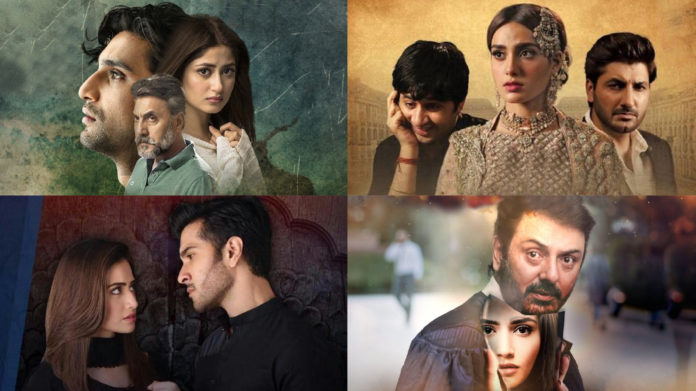Dramas and stories have the ability to captivate and influence the audience with their intricate narratives, compelling characters, and emotional depth. Dramas can provoke strong emotions and leave a lasting impact on the audience. While some Pakistani dramas fall in the category of mindless watches that are solely for entertainment, others teleport you to different worlds that make you ponder and question your beliefs.
Hence, the ever-going debate about whether it is entertainment or social awareness that takes precedence when it comes to producing a drama. The fine line between the two is indeed hard to achieve thus giving rise to several questions.
The Entertainment Value:
For many, dramas are a form of escapism that provides the much-needed break after a day of chores and work. Some viewers demand a mindless watch that they can binge watch. Some would prefer a cheesy romance while others would like to sit for hours watching a sitcom.
Ramadan Dramas Provide Entertainment
Case in point, Ramzan dramas have won over the audience’s heart every year due to the light-hearted storylines and captivating characters that only provided entertainment and a channel to unwind, without carrying the burden of giving a social message, that can often leave a gloomy impact on the viewer.
Suno Chanda, the pioneer of Ramzan drama in Pakistan is a classic example of this phenomenon. The show garnered millions of views and has a huge fan base, as the drama fulfilled the unexpected need of Pakistani television audience- a comedy show with a solid plot to binge watch.
However, what if entertainment comes at the cost of leaving a cynical impact on the audience?
The Costs of Entertainment
We have seen this concept unravel several times in Pakistani dramas. You have dramas like Jhooti, in which Iqra Aziz played the character of a compulsive liar. Also, Bilal Abbas and Sana Javed’s drama Dunk which is the story about false harassment allegation. Even though the premises are questionable, both the dramas got millions of views.
Lastly, how can we forget to mention the iconic drama, Mere Paas Tum Ho in which Khalil-ur-Rehman penned down a story of a woman leaving her husband and child for a man who could offer her a life of glamour and glitz. The drama had an unmatched popularity and was certainly entertaining the masses, so did the drama did its job well or was the lack of a social message problematic?
Social Impact of a Drama:
There are countless examples of films, dramas, documentaries made around the world to educate the audience. Choose a societal issue and we assure you that you are likely going to find a work of art made on it to educate the audience around the globe. Pakistani dramas have been known for having strong plots that deliver an even stronger message.
Remember, the classical hit Zindagi Gulzar Hai? While a romantic drama to its core, the drama gave an important message of exclusivity, eliminating gender biases and discrimination against children. The drama left an impact on viewers and we are certain that it gave a food for thought to many.
Other dramas like Udaari that talked about incestuous rape and Ranjha Ranjha Kardi that highlighted mental health issues were a subject to discussion by thousands of people and was watched by millions. The drama educated the audience about these sensitive issues and presented optimistic stories that were a hope for those who were going through a similar phase.
Are Morally Grey Characters Acceptable on Television?
While creative freedom plays a big role when it comes to writing, directing, or even acting, when it comes to showing morally grey characters on television, it is often subjected to debate and frowned upon-unless the character is depicted to be charismatic.
It is a grey area when it comes to depicting grey characters-pun intended-while some believe that it shows the human side of the audience which makes the characters more likeable and more interesting to watch because at times you can relate with their irrational decision making or understand where they are coming from, as we all are humans at the end of the day, prone to make mistakes.
Armaanullah from Ye Dil Mera
Case in point, Armaanullah in Ye Dil Mera, who was essayed by Ahad Raza Mir. The character was likeable and charming, and you even sympathize with him for his childhood trauma even though you do get shady vibes from him since the first episode.
Others might argue that essaying of morally grey characters can often confuse the audience making them idealize wrong role models.
Toxic Characters are Often Adored
We have seen this over the years when toxic male characters are romanticized and adored. Character Mir Hadi of the hit drama serial Khaani played by Feroze Khan was another favourite of the audience in Pakistan and across border.
A classic example is of the drama Kaisi Teri Khudgarzi in which the character Shehreyar is smitten over by millions of viewers even though he abducts, threatens, and forcefully marries the girl he likes who eventually falls in love with him.
The truth is that the right balance is hard to achieve. Morally grey characters often garner a lot of praise and provide great entertainment value but at the end the viewers should try to differentiate between real vs reel life.
Highlighting social issues: Sensationalism or social responsibility?
Production houses like Kashf foundation have given us dramas that are deeply rooted into translating a social message to the audience. Take the example of Dil Na Umeed Toh Nahin or Udaari that were primarily made to educate the audience.
However, it hasn’t gone unnoticed that in recent times some sensitive issues such as rape or domestic violence are ‘sensationalized’ just to get views from the audience, without them being a substantial part of the plot.
This makes us question whether the drama makers are blatantly monetizing on social issues, resulting in normalizing and trivializing such matters.
The key lies in drama makers trying to achieve a delicate balance between the two objectives. Excess of anything is bad. The perfect combination is achieved when the makers try entwine the two concepts together.




